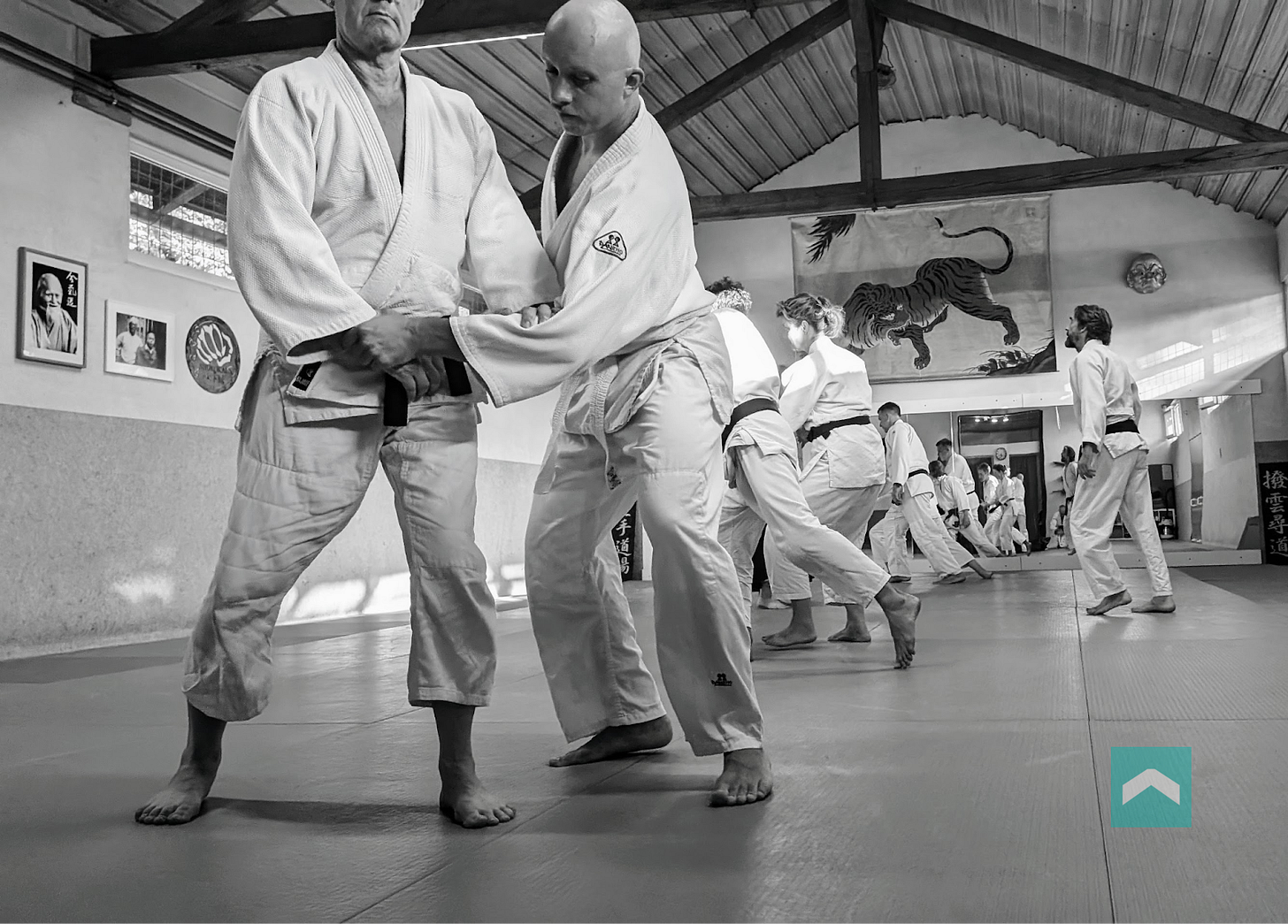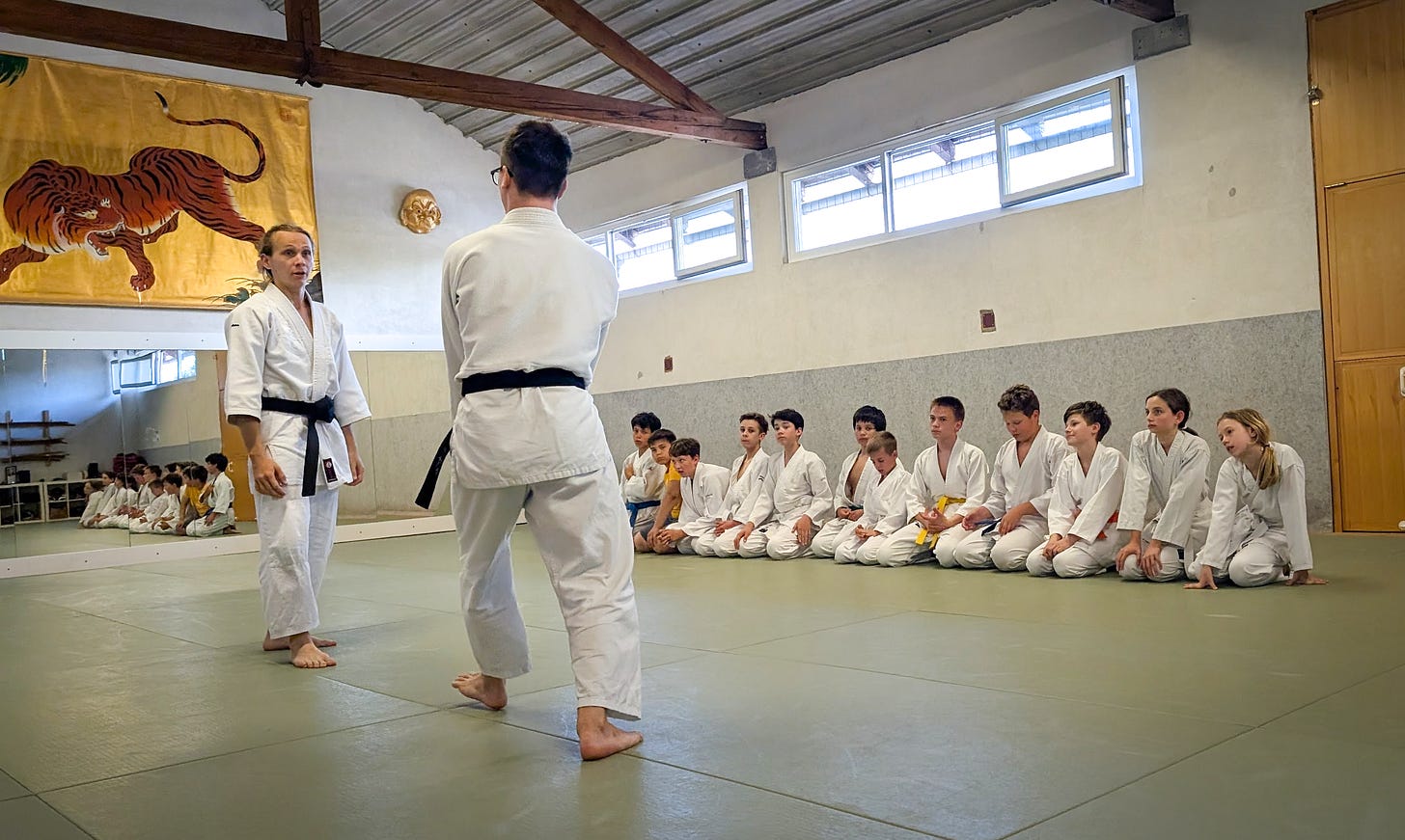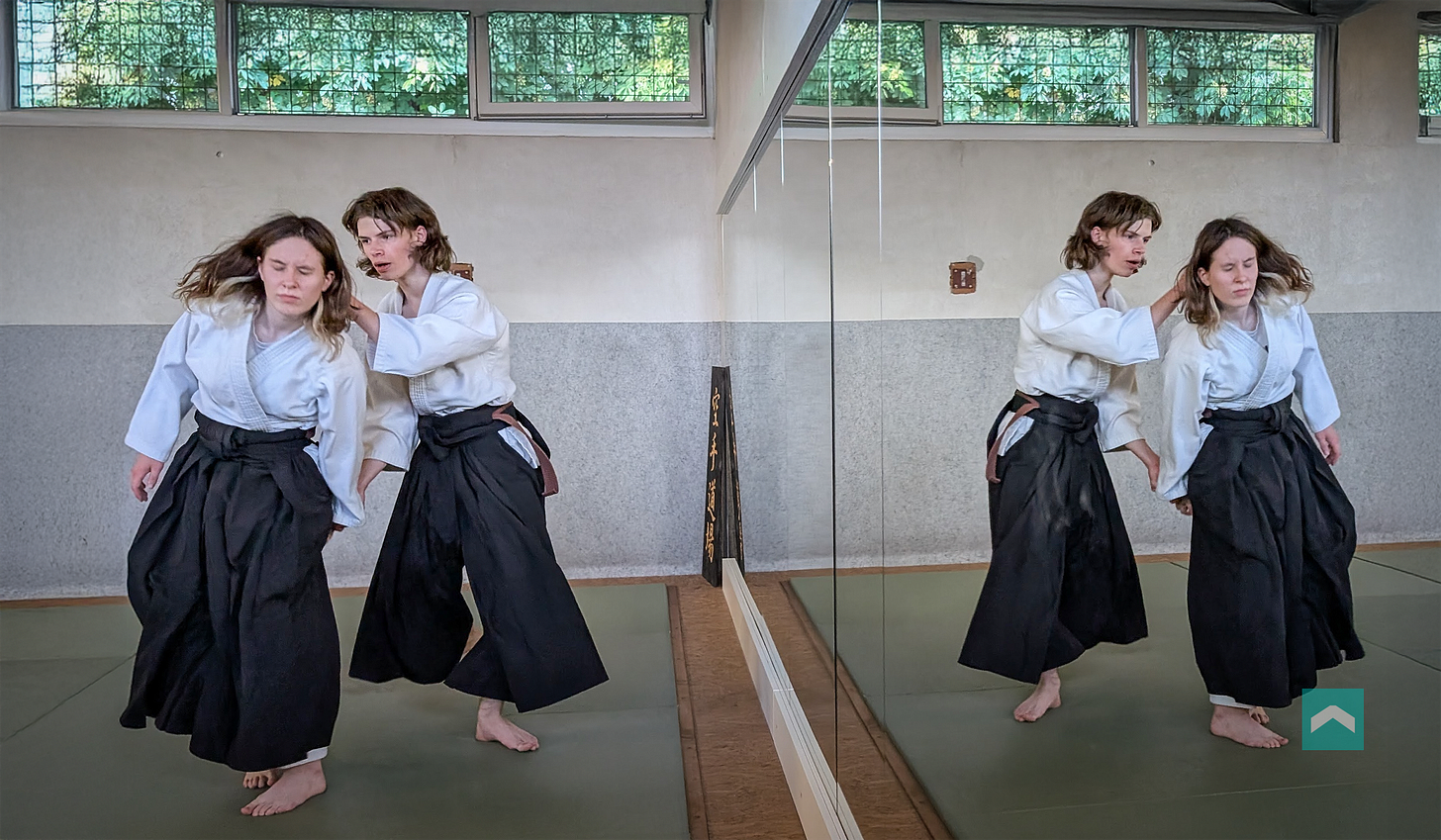From tension to flow: Aikido training with clarity. Part 3
Track how Relaxation, Stability, and Clarity refine from coarse to subtle levels to better understand your internal progress and apply these principles more effectively.
In Part 1 (start there if you haven’t read it yet), I shared what led me to write this series—realizing that copying external form isn’t enough to make Aikido work. There’s an internal foundation that needs to be developed, and vague advice like “just relax” won’t get you there.
Part 2 introduced the Core Framework: Relaxation, Stability, and Clarity. I explored how these qualities evolve from early practice to more advanced levels—and how they reinforce each other as internal skills, not just outward technique.
This section explores how these qualities evolve as your practice deepens. It serves as a bridge between understanding the principles and applying them effectively, setting the stage for the final part: practical strategies you can use both on and off the mat.
Progression from Coarse to Fine Levels
As our Aikido practice evolves, so too do the qualities of relaxation, stability, and clarity. These aren’t static traits we acquire once and keep—they unfold differently depending on the depth of our training. At each level of refinement, these three elements appear in new forms: sometimes crude and effortful, sometimes subtle and integrated. The structure that follows combines my own direct experience with practical insights into how these qualities manifest and can be cultivated across stages of progression:
Coarse Level: Basic Relaxation, Mechanical Stability, Emerging Clarity
In my early years, relaxation meant trying not to tense up. It was mostly physical—unclenching my jaw, loosening my grip, remembering to breathe. Still, I often left training sore, not from falls, but from fighting against myself the entire time. Stability meant locking my posture and hoping I wouldn’t get knocked off balance. Clarity was limited to recalling sequences, and even that fell apart under pressure. Everything felt effortful—and yet, looking back, this stage was necessary. It taught me to notice what wasn’t working.
At this level:
Relaxation is mostly about letting go of visible muscular tension. Practitioners begin to explore softness in the limbs, breath awareness, and how excess effort interrupts motion. This foundational form of relaxation creates the first possibility for movement to become responsive instead of forced. It also opens the door to noticing where tension is stored—shoulders, jaw, or even in the breath—and where it can be softened.
Stability begins with mechanical foundations: refining stance, adjusting alignment, and repeating movement patterns. In early stages, it often feels rigid—tension is mistakenly used to create control. To develop functional stability, practice should focus on grounded posture and maintaining balance under slow, predictable pressure. This creates a structure that can absorb weight and support movement without stiffening or collapsing.
Clarity, while limited, begins to grow through repetition and simple correction. Knowing where to place hands or how to enter with proper timing creates a baseline awareness that helps reduce panic or confusion during practice.
Intermediate Level – Embodied Relaxation, Responsive Stability, Relational Clarity
Things started to change when I got tired of struggling. One day I slowed everything down—not to perform better, but just to feel what was going on. I began noticing the weight in my feet, the tightness in my hands before contact, and how often I stiffened when something unexpected happened. The shift wasn’t dramatic, but it was unmistakable: less pushing, more sensing. Movement became quieter, and I stopped trying to control so much. It felt like I was finally training with my body, not against it.
At this level:
Relaxation deepens into awareness. Practitioners begin to detect tension as it arises and respond by softening mid-movement, rather than after the fact. Breathing becomes more continuous, and transitions feel smoother. This type of relaxation supports adaptability, allowing the body to stay open and fluid even when surprised.
Stability – At this stage, stability is no longer about holding your ground, but about remaining organized while moving. You begin to sense pressure, direction, and timing through your whole structure. This allows you to adapt smoothly without bracing or overcorrecting. To cultivate this quality, responsive drills introduce changing tempo, pressure, and points of contact. These conditions train the body to stay composed and organized through transition—so structure continues to support the flow rather than interrupt it.
Clarity now extends beyond one’s own form: you start to recognize your partner’s rhythm, posture shifts, and balance lines. This relational clarity enables earlier, more appropriate responses.
Advanced Level – Mental Relaxation, Intentional Stability, Intuitive Clarity
This was by far the hardest level for me—not just because I’m an analytical type who tends to overthink, but because of how deeply my emotional disposition got in the way. Frustration, irritation, and anger—these reactions weren’t always visible to others, but I could feel them interrupting the flow from the inside. I tried to mask it with technique, but the truth was that I hadn’t yet found emotional relaxation. What helped most was recognizing that this tension had roots—and once I acknowledged what was happening, the shift began—not quickly, but steadily.
At this level:
Relaxation shifts from physical to mental and emotional. The challenge is no longer just to soften muscles, but to soften resistance—to release the urge to control, to judge, or to defend oneself internally. Letting go of the need to get it right, or to prove anything, becomes essential. Emotional relaxation opens the way to fluid, non-reactive presence—even in fast or pressured exchanges.
Stability takes on a more intentional quality and includes composure under pressure, structural continuity, and seamless transitions. You remain aligned through complexity—not by holding still, but by staying connected throughout movement. Techniques are sustained from beginning to end with quiet precision. To support this, training should involve continuous movement sequences and pressure drills that challenge the body’s ability to remain composed under shifting intensity without disrupting the internal structure.
Clarity at this stage no longer comes from analyzing or breaking technique into steps. Instead, the entire arc—from initiation to completion—is already sensed before movement begins. You act with full presence, not by planning every detail, but by allowing your trained attention to guide the response. Mental and emotional energy, rather than causing interference, can now be channeled into movement—giving technique immediacy, intensity, and direction without hesitation.
Refined Level – Unified Relaxation, Integrated Stability, Embodied Clarity
I hesitate to speak about this stage as if I’ve mastered it—I’m only beginning to touch it, catching occasional glimpses, usually in moments when I stop trying to prove anything. In those rare instances, there’s no effort to relax, no strategy to stay balanced, no thought about clarity. Movement simply happens, and I find myself fully present within it. It’s quiet. It’s simple. And, ironically, often invisible to others. But for me, it feels like truth—or something very close to bliss.
At this level:
Relaxation is no longer something applied—it’s something embodied. There’s nothing to release because nothing is being held unnecessarily. The practitioner doesn’t try to relax—they simply don’t interfere. Breath, attention, and movement are unified in a single expression.
Stability here is fully integrated. It doesn’t appear as something you hold—it arises automatically in movement. It is responsive, resilient, and invisible. There’s no visible bracing or adjusting; alignment just sustains itself in motion.
Clarity becomes panoramic and embodied. You see the whole situation before acting—not as a conscious calculation, but as direct knowing. Training at this level focuses on refining presence: drills that demand precision under pressure, moving without interruption, and navigating high-speed dynamics with seamless awareness.
At this stage, relaxation, stability, and clarity merge into a singular expression, where technique flows effortlessly, embodying the essence of Aikido.
Comparisons to Other Disciplines
While this framework is rooted in Aikido, its principles resonate across various disciplines, highlighting a universal approach to mastery and refinement.
In Tai Chi and internal martial arts, practitioners transition from relying on muscular effort to cultivating an effortless energy flow, much like the progression from physical relaxation to fluid movement in Aikido.
Zen and mindfulness practices emphasize the shift from external distractions and overthinking to a state of pure presence, mirroring how Aikido training moves from cognitive processing to intuitive embodiment.
Japanese sword arts (Kenjutsu) follow a similar path, where beginners start with rigid, mechanical cuts and gradually refine their technique into seamless, instinctive motion.
Even in sports psychology, elite athletes perform at their best when in a state of "relaxed concentration"—a mental zone often referred to as a flow state, where movement becomes effortless, decisions are immediate, and performance reaches its peak.
This shared progression across disciplines reinforces the idea that mastery is not about force or control, but about relaxation, stability, clarity, and deep connection with the moment.
Interlude
Attention vs. Awareness in Practice
In training, it’s important to understand the difference between attention and awareness:
Attention is the mind’s spotlight. It focuses on one specific thing—such as relaxing your grip, keeping your center low or maintaining constant connection with your partner. Attention is deliberate and selective.
Awareness is the background field. It monitors the broader environment—your partner’s movement, your balance, the overall flow of technique. Awareness is spacious, inclusive, and less specific.
Both are essential in Aikido practice.
During technique
Maintain attention on a single internal adjustment you chose (for example, softening your shoulders immediately after contact). This ensures depth and consistency in refinement.
Simultaneously, sustain background awareness of yourself and your partner—posture, connection, timing—without letting attention jump around or scatter.
When distractions arise (like thinking, overreacting, or worrying), gently return attention to the specific element you’re adjusting, such as breath, contact, or center. Keep your awareness wide and relaxed, including your partner and the flow of the technique.
Over time, this ability to be mindful of your movement makes your perception and execution sharper, your reactions more immediate, and your presence deeper—while remaining relaxed and responsive, not tense or rigid.
Mindfulness as Not Forgetting
In this context, mindfulness simply means not forgetting—maintaining attention and awareness from start to finish within a technique. It sounds simple, but it isn’t. Some of my most advanced students still lose it in motion. I often see it in their gaze: they turn their head, glance away, and clarity vanishes.
In these moments, I break the technique into smaller phases and ask them to focus mindfully on just one element, while staying aware of the whole. The goal is to cultivate presence in motion, rather than control.
Mindfulness is often dismissed these days as vague or overused, criticized for being poorly defined or applied inconsistently. But here, it’s practical. It's about remembering what you're doing, and sustaining that intention.
The Role of Breath
At every level of training — and within each quality (relaxation, stability, clarity) — breath guides the transition:
Breath supports relaxation by softening unnecessary tension.
Breath settles stability by aligning structure and calming reactivity.
Breath sharpens clarity by reducing mental noise and anchoring intent.
Each time you move through the spiral of refinement, awareness flows more easily when the breath is conscious and steady. If attention drifts or tightens, returning to the breath reopens the connection.
No matter what level you’re at, breathing isn’t an add-on — it’s the carrier of awareness.
What’s coming next
In the final Part 4, we’ll focus on practical application. You’ll learn how to train with the principles of Relaxation, Stability, and Clarity during class—especially when something feels off or doesn’t work as expected. I’ll also cover simple ways to reflect after practice, so you can recognize patterns, refine your internal work, and adjust your approach with more precision.





